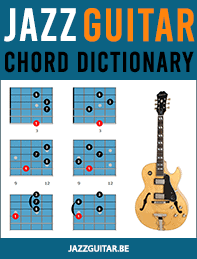A favorite of jazz guitarists such as Joe Pass, who used these shapes to perfection in his solo guitar performances, drop 3 chords are ideal to use when playing in a solo or duo setting. While they might take a bit of time to get under your fingers, having a strong understanding of drop 3 chords will greatly expand your Jazz guitar comping, chord soloing, and chord melody playing. Experiment with the fingerings for these chords as different hand sizes will use different fingerings.
Here’s why drop 3 chords are so popular:
- With a strong sense of bass in each chord (the lowest notes are always on the 6th or 5th strings), drop 3 chords will give you that fat-bottom sound when covering the low end in a bassless duo or trio setting.
- Because there is a string skip in every shape, drop 3 chords are ideal for solo guitar playing, as they keep the bass notes involved in your voicings, but separate them from the rest of the chord, allowing the melody line to stand out at the same time.

THE JAZZ GUITAR CHORD DICTIONARY (FREE eBOOK)
Download now and learn 244 chord shapes!
Drop 3 Guitar Chords Chart

Practicing Drop 3 Chords
When practicing drop 3 chords, there are two main ways to get these chords under your fingers, before taking them to your favorite Jazz standard and applying them to tunes in your studies:
1. The first way to practice drop 3 chords is to learn each inversion on one string set:
- Take Cmaj7 on the 6432 string set and play all four inversions of that chord from memory.
- Move on to Cmaj7 on the 5321 string set and play all four inversions of that chord from memory.
- From there, play all 8 Cmaj7 drop 3 chords to cover the entire fretboard.
Here is an example of that exercise on the 6th string with Cmaj7.
Listen & Play Along

2. The second way to practice drop 3 chords is to work on inversions across all chord types:
- Play the root position, 6432 string set, for Cmaj7, C7, Cm7, Cm7b5, and Cdim7 chords.
- From there, play the 1st inversion, 6432 string set, for Cmaj7, C7, Cm7, Cm7b5, and Gdim7 chords.
- When you can do the 1st inversion, move onto the 2nd, and 3rd inversions for the 6432 string set, before repeating the exercise on the 5321 string set.
Here is an example of that exercise on the 6th string with each chord type in root position.
Listen & Play Along

More chord charts:


Left-handed versions of E Books please!
The inversions are wrong, no?
If r357 becomes 3r57….
The true inversions would be
R573
573r
73r5
Hi Gary, you need to take the THIRD HIGHEST, you start from the top. Second lowest is another way to think of it. You are taking the SECOND HIGHEST.
Your chords are Drop 2 chords instead of Drop 3.
Anthony
Thank you so much, this is essential as grammar is to language. This is gold thanks !
One quick question about the building of those chords…You said “dropping the third highest note” but in the example your are dropping the second highest note.
Why ?
Hi Sam, in the example the A of Fmaj7 (FACE) drops one octave. A is the third highest note, F being the lowest note (the bass note) and E being the highest note.
No actually is the third highest notre dropped here. Look at the chords and read it from top to bottom, you will see it’s the third from the top. It confused me too at first.
Great lesson thank you dirk lanukens
Do I understand correctly that drop 3 chords do not have “pairs” intervals like drop 2 (1-5, 7-3)?
Aren’t a lot of the voicings in the inversions really inefficient and easily replaceable? Besides the root position (shell voicings), I see most of them except a few (Minor 7b5 in 1st inversion, Maj7 in 1st inversions, etc.) really unnecessary and can be replaced with other chords with easier fingerings that still have the same top note for the melody. Wondering if it is just me.
Fantastic explanation and presentation of drop 3 chords. Would using these or drop 2 chords for chord melody be down to personal choice or would one set be preferred over another for different reasons? I’m currently learning my first standard properly (All the Things You Are) and I am using drop 3 chords for my chord melody and they sound great. I haven’t moved on to drop 2 chords yet so I was just wondering if there’s a reason why you would choose one over the other?
Thanks so much!
Mike
Hey,thankz for the chord lessons,ill get to work at onces and plz ill like to get more guitar chords lessons.
Clear and great lesson Dirk
Thanks
Great Lesson Dirk!, I look forward for the ebook. Thanks, Carlos
Great chart
really crystal clear, thank you so so so much
i think I’ll print it & hang it on wall, so good
🙂
Hello, Thanks the image appears to be fixed now. Quick question about the Cm7/Eb with the bass note on 6th string, isn’t that also a Ebmaj6 chord shape – same chord with 2 names? Thanks. Saga
Yes, that’s the same shape. Nice one!
the name of the chord depends on its function within the sequence
Yes, Cm7/Eb (Eb G Bb C) has the same notes as Eb6 (Eb G Bb C).
Thanks very much. This is an excellent summary of the Drop 3 chords. I look forward to the ebook. Will the e-book also reference the Drop 2 and Shell chords? When do you anticipate its release?
Gordon
Hey Gordon, I’ll finish the ebook around October, it will be a free one…
Thanku dirk laukens